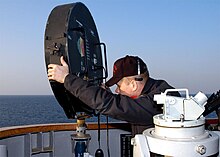Long range acoustic device

The Long Range Acoustic Device (LRAD, also known as sonic cannon ) is an acoustic device used by the US armed forces , with which both normal loudspeaker announcements and painfully loud tones can be broadcast.
History of the LRAD
The LRAD was developed as a non-lethal weapon on behalf of the United States Department of Defense . The LRAD is an acoustic weapon that was already in use in the second Iraq war . In the port of Basra it is also used to enable loudspeaker announcements to be made to ships.
The manufacturer of the LRAD is the American company American Technology Corporation . According to a spokesman for the shipping company , an LRAD installed on the ship was used to ward off an attack by pirates off the Somali coast on the cruise ship Seabourn Spirit on November 5, 2005.
In the USA, LRAD was used for the first time to disperse unauthorized demonstrations on the sidelines of the G20 summit in Pittsburgh in 2009. The American Association of Audiologists is of the opinion that LRADs should be banned from use for demonstration control for health reasons.
How the LRAD works
With the LRAD, acoustic signals in the range from 2100 to 3100 Hertz are emitted with a maximum sound pressure level of around 150 dB . Due to the high sound pressure , the tones can be heard over a distance of at least one kilometer. Announcements should be understandable up to 500 m.
The high-pitched tone that can be used by the LRAD leads to a strong pain stimulus at close range.
The device can be aligned with a beam angle of 15 to 30 degrees (according to another source 20 to 25 degrees) in a certain direction and, according to the manufacturer, can e.g. B. can also be used to disperse demonstrators.
According to the Bugsier-Reederei , it should be used in the shipping sector : The LRAD should be used to warn of wind turbines in the numerous offshore wind farms currently under construction in the North and Baltic Seas .
Consequential damage
Applications over a longer period of time and the exposure of potential target persons to sound can lead to mild to severe hearing damage with the appropriate sound pressure and distance from the source . However, wearing hearing protection negates the effect as a weapon.
Web links
- "Sound-Laser" , article dated September 22, 2005 by Telepolis
- Defense against pirates - The shipowners ' ineffective high-tech weapons , article from December 19, 2008 by Spiegel Online
- Long Range Acoustic Device (LRAD) G20 Pittsburgh - YouTube Video - Retrieved August 20, 2019
Individual evidence
- ↑ Eigel Wiese: Defense without weapons . In: Hansa . Issue 8, Schiffahrts-Verlag Hansa, Hamburg 2012, ISSN 0017-7504 , pp. 72-74.
- ↑ Andrew Clark: Pittsburgh deploys teargas and sirens to keep G20 demonstrators at bay. theguardian.com, accessed August 20, 2019 .
- ^ Matthew Rozsa: Police are using sonic weapons against protesters that can cause permanent hearing loss. In: Salon. June 22, 2020, accessed August 11, 2020 .
- ↑ Ann-Katrin Wehrmann: Strong loudspeakers should increase safety in offshore wind farms . In: Hansa . Issue 6, Schiffahrts-Verlag Hansa, Hamburg 2012, ISSN 0017-7504 , p. 64/65.
